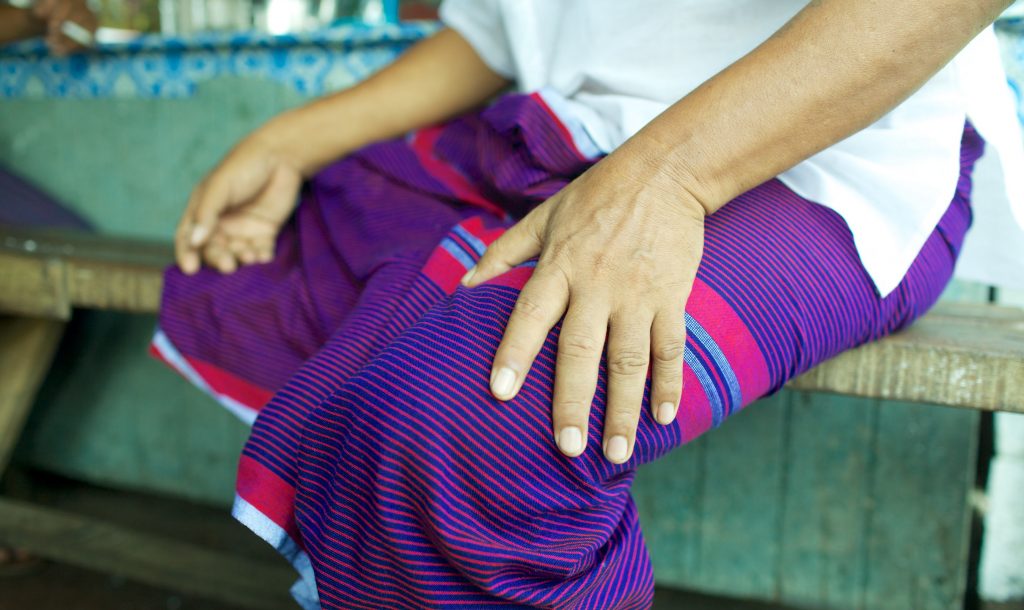In the face of rapid change and incredible political transformation, Luke Corbin looks at the lifespan of one Myanmar’s most iconic items.
Look out at the street: what do you see men wearing?
I’m willing to bet there are at least a few well-tied longyis wrapped around bellies outside, wherever you are in the country.
The longyi has proliferated in Myanmar since British colonial times. The masculine, tubular garments as we know them today first became popular in the nineteenth century, gradually replacing the formal paso, a much larger, more regal array of male dress, and becoming the common garment for men of all classes.
While skirts the world over have nearly always predated trousers (which only became popular when Eurasian cultures domesticated the horse) the longyi as a particular phenomenon is regional to the Bay of Bengal, with mild pronunciation differences across the Bay’s main languages.
In West Bengal they come most often in hues of light blue; in Bangladesh you can find quite radical and experimental patterns. Here in Myanmar the longyi is at its most refined: subtle grids, firm lines and crisp hems in quality coloured silk and cotton.
In Kolkata, the longyi is considered a Muslim, lower-class form of dress, paired mostly with a white singlet. In Salt Lake City, a middle-class suburb of the city, I was even refused entry to a restaurant because of my longyi.
Once the largest city in the ‘longyi belt’, and historically a longyi-majority zone, Kolkata has now turned on them. If you wear one there now, you are considered a Muslim; and probably a poor one at that.
While Westerners with white skin are desirable customers the city over, if you are wearing a longyi you may find yourself barred from “A/C level” venues – like I found myself.
In the cities of Dhaka, Yangon and Mandalay certain combinations of shirt and longyi can denote one’s occupation or trade – and then of course there are the school uniforms. Interestingly, many patterns adorning Myanmar longyis are marked as being of “ethnic” origin, although the attribution may be more a matter of branding than strictly representative.
I own several “Chin” longyis but have never seen one worn by anyone in Chin State, nor seen them for sale in any of the hill towns. There are several cultural groups in Myanmar that rarely if ever traditionally wore longyis, finding themselves only recent inheritors of the dress for sale in “traditional patterns” at a department store near you.
There is clear utility to the longyi: it’s simple and cheap to manufacture, can double as a towel or sheet and is perfectly suited to Myanmar’s climate with its ability to provide “natural A/C”. And of course, for those who care to risk the risqué, you can go really “breezy” and sans underwear.
This cooling ability is intuitive and easily recognised: when crossing outback Australia in a longyi during a heatwave in 2012 I received many jealous comments from the less fortunate sweating it out in pants. When responding to the sticky and uncomfortable I was only too happy to sing the praises of a skirt in summer.
If any doubters exist, I challenge them to walk to their local Myanmar market: first in shorts of their choosing, then in a longyi. Let the dampness decide.
But for all their utility, for all their deserved respect, the longyi is in danger.
European-style costume has been steadily dominating the world since the industrial revolution, leading to a superficially homogenous array of dress flourishing across the oceans. It is a vision of young people sweating in Levis from Makassar to Bogota.
The longyi has resisted this push until today, stubbornly remaining popular due to its utility and – let’s be honest – partly as a consequence of Myanmar’s political history. Wearing pants was for a time considered an act of politics, not just of style.
But times have changed and trousers are on the rise in Myanmar. Jeans in particular appear to be leading the charge. I swelter witnessing so much tightly-clad denim on a thirty-five degree day, snaking serpentine, constricting the legs of Myanmar’s Millennials. I can only imagine the plight of their pores, broiled to burning temperatures, inviting heat rash with every rub and shuffle.
The recent increase in digital and video advertising reflects this trend. It has become routine for Generation Y and Millennials to be represented in pants or jeans on-screen, especially if the advertisement is tapping into the ubiquitous narratives of “change”, “modernisation”, “cosmopolitanism” or the “global economy”. In the same advertisements, if there is a longyi at all, then it is worn by older generations and authority figures.
Is this the future we want for the longyi? Being relegated to the “old guard”? Then again, why should Myanmar males be forced to choose between pants and longyi?
A synergy could arise. In the early twentieth century it was popular for urbane men to wear their longyis with English-style leather belts and dress shoes. Could we see denim longyis in the future? Carefully-aged rips at knee height? Longyis with cargo pockets? It would be better than no longyis at all.
Postmodern fashion designers of the future: do not forget the longyi. Respect it. And may we never see the day a Myanmar restaurant refuses entry to the breezy, the bold, the beautiful longyi.
Luke Corbin is a PhD candidate in the School of Culture, History and Language at the Australian National University, and a member of the ANU Myanmar Research Centre.
This article is a collaboration between New Mandala and The Myanmar Times.
 Facebook
Facebook  Twitter
Twitter  Soundcloud
Soundcloud  Youtube
Youtube  Rss
Rss 